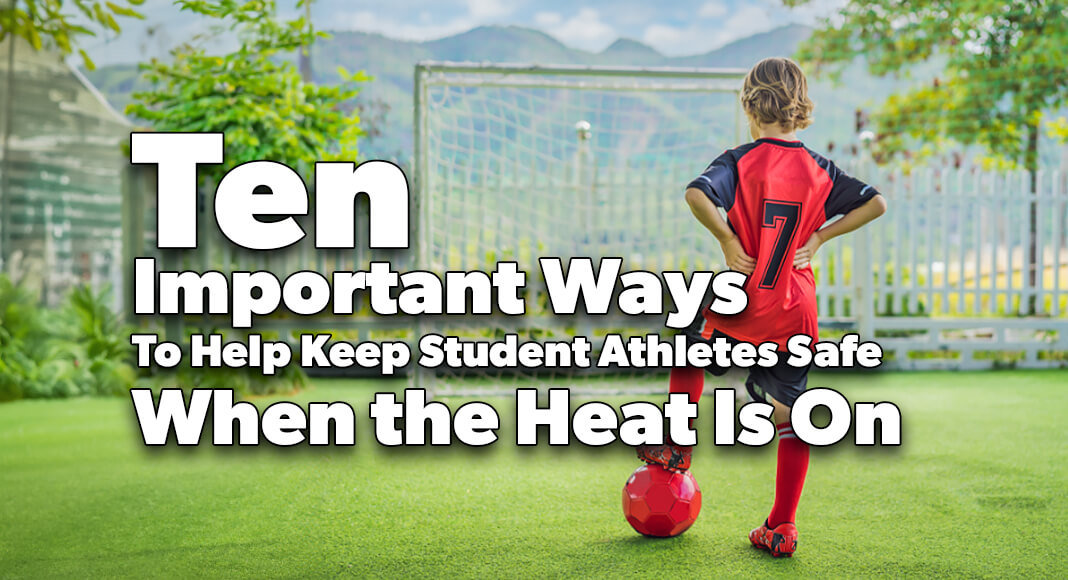
Mega Doctor News
AMERICAN RED CROSS – This summer has seen extreme heat linger over a large swath of the country. As student athletes begin to prepare for the upcoming fall season, coaches are reminded that heat and humidity can be especially hazardous for their young players.
The American Red Cross offers ten ways coaches can help keep players safe.
- Avoid scheduling outdoor workouts and exercise during the hottest times of the day — schedule them for early in the day or later in the evening.
- Reduce the intensity of workouts or exercise until athletes are more accustomed to the heat.
- Encourage players to drink plenty of water to avoid muscle cramping or heat-related illness. Fluids should be consumed frequently during strenuous activity and within a half hour of training.
- Incorporate warm-ups — even high school athletes need to stretch their muscles before strenuous exercise to help prevent injury.
- Plan frequent and longer breaks. Ideally, pause practice about every 20 minutes for athletes to drink fluids and rest in the shade if possible.
- Reduce the amount of heavy equipment athletes wear in the extremely hot weather. Instead, encourage net-type jerseys or lightweight, light-colored cotton T-shirts and shorts.
- Use the buddy system to encourage athletes to drink water and watch for signs of illness in their teammates.
- Know the signs of heat cramps, heat exhaustion and heat stroke.
- Have an emergency plan in place. Emergency situations may arise at any time during athletic practices and events. Knowing what to do and how to respond quickly are critical in providing the best possible care to the athletes in emergency situations.
- The first responder to an emergency situation is, typically, a member of the training, coaching, strength, or physician staff. Prepare for the unexpected with first aid and CPR training from the Red Cross. We offer both in-person classes and online training. Through our classes, you will not only learn how to perform first aid but have the confidence and skills to do it correctly. Learn more here.
HEAT-RELATED EMERGENCIES
HEAT CRAMPS are muscle pains and spasms in the legs or abdomen. Heat cramps are an early sign of trouble, and athletes should inform those in charge if they are not feeling well. If someone is experiencing heat cramps, get them to a cooler place to rest, lightly stretch the affected muscle, and slowly replenish their fluids with a half a glass (about 4 ounces) of cool water every 15 minutes.
HEAT EXHAUSTION is a more severe condition signaled by cool, moist, pale or flushed skin; heavy sweating; headache; nausea or dizziness; or weakness and exhaustion. To treat heat exhaustion, move them to a cooler place, remove or loosen tight clothing and spray the person with water or apply cool, wet cloths to the skin. If they are conscious, give small amounts of cool water to drink slowly. If the person refuses water, vomits or begins to lose consciousness, call 911.
HEAT STROKE Heat stroke is a life-threatening emergency when someone is overwhelmed by heat and their body begins to stop functioning. Signs include hot, red skin that could be dry or moist; changes in consciousness; vomiting and high body temperature. Call 911 immediately if someone shows signs of heat stroke. If possible, move the person to a cooler place and immerse them up to their neck in cold water. Otherwise, douse or spray the person with cold water, or cover the person with cold, wet towels or bags of ice.
DOWNLOAD OUR FIRST AID APP The Red Cross First Aid app puts instant access to information on handling the most common first aid emergencies at your fingertips including heat-related emergencies. Download this app by searching for ‘American Red Cross’ in your app store or at redcross.org/apps.









